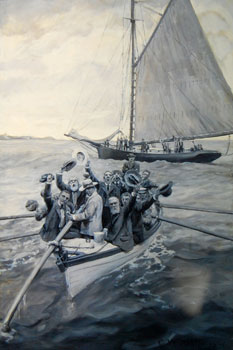- Page:
- 1 /
- 2
At the Wharf
It was here that ships were loaded and unloaded, outfitted, and repaired. A team of ships' carpenters and caulkers finished doing basic repair work on a vessel that didn't require a dry dock. Once a ship was floating again "on an even keel," it was time for the riggers to climb aloft, hoist and set the topmost sections of masts in place.
On an adjacent wharf, stevedores or dock laborers delivered supplies to a ship that was setting out within the week. Barrels of beef, pork, hardtack (or ship's bread), flour, and other supplies were stowed in the hold. Potatoes and vegetables were stored in "the pen," while the cook organized things in the galley. Lots of chickens and pigs were brought on board, and sometimes goats or even a cow to provide fresh meat, milk, and eggs. Men also stocked clothing, blankets and tobacco for the slop chest. This became the ship's store from which a seamen could purchase personal goods during a voyage.

Courtesy of the Trustees of the New Bedford Free Public Library